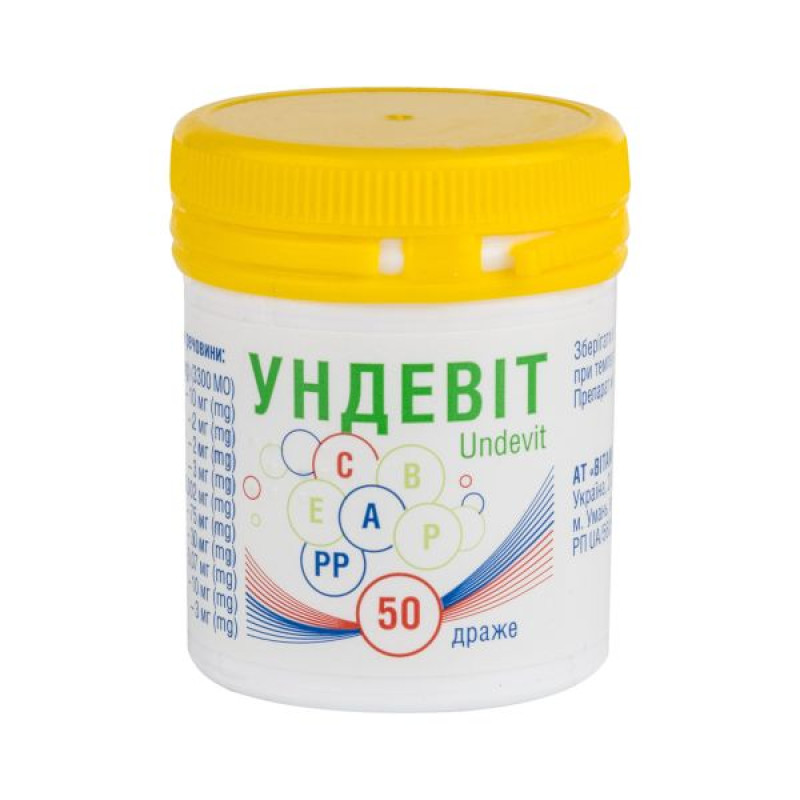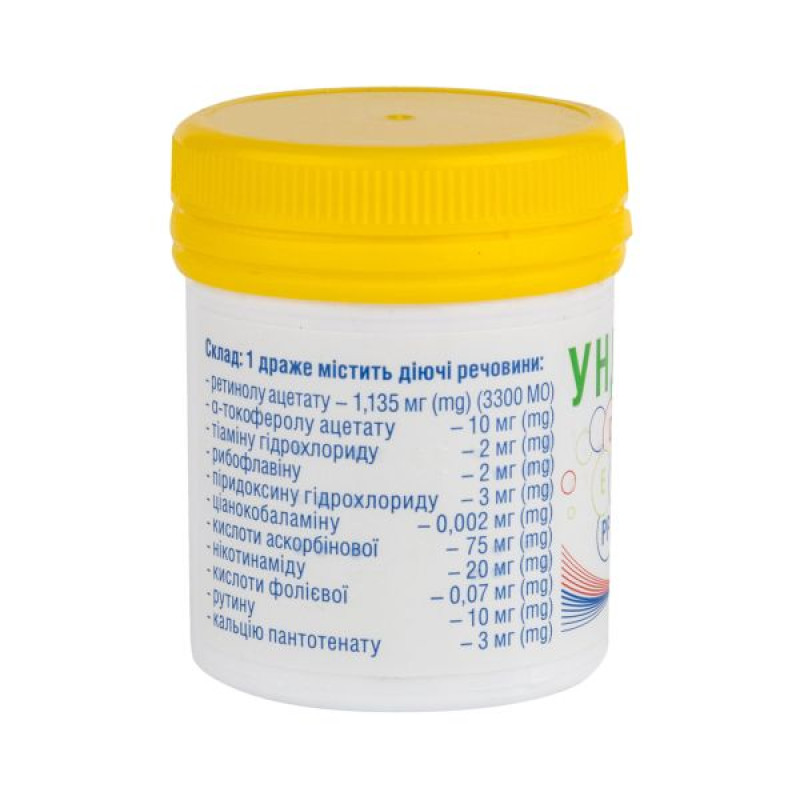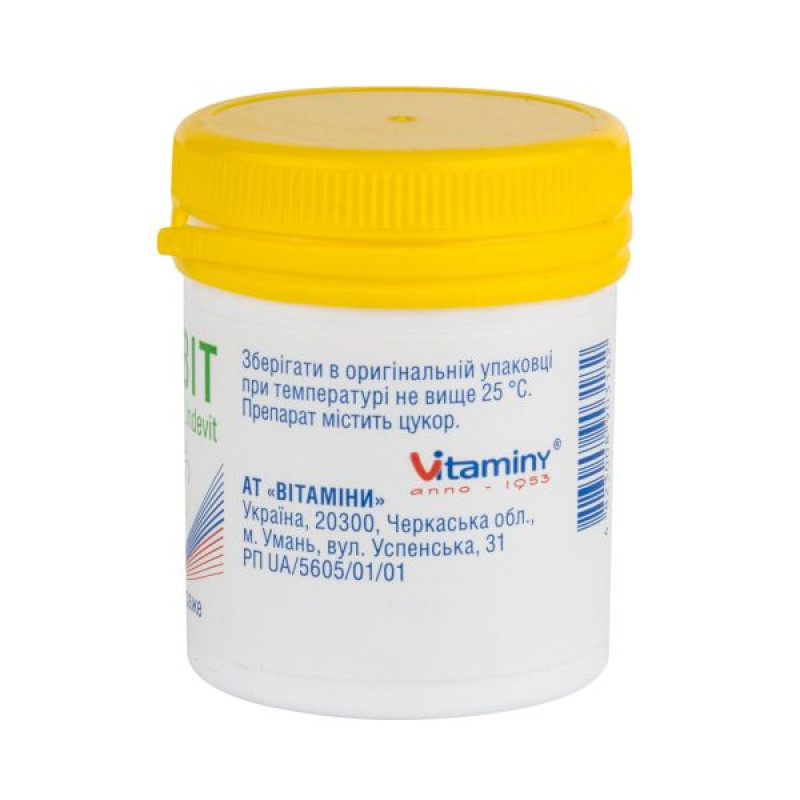Undevit dragee container No. 50

Instructions for Undevit dragee container No. 50
Warehouse
active ingredients: retinol (vit A), tocopherol (vit E), thiamine (vit B1), riboflavin (vit B2), pyridoxine (vit B6), cyanocobalamin, ascorbic acid (vit C), nicotinamide, folic acid, rutoside, calcium pantothenate;
1 dragee contains retinol acetate (vitamin A) calculated as 100% substance – 0.001135 g (3300 IU), a-tocopherol acetate (vitamin E) calculated as 100% substance – 0.01 g, thiamine hydrochloride (vitamin B1) calculated as 100% substance – 0.002 g, riboflavin (vitamin B2) calculated as 100% substance – 0.002 g, pyridoxine hydrochloride (vitamin B6) calculated as 100% substance – 0.003 g, cyanocobalamin (vitamin B12) calculated as 100% substance – 2 μg, ascorbic acid (vitamin C) calculated as 100% substance – 0.075 g, nicotinamide calculated as per 100% substance – 0.02 g, folic acid per 100% substance – 0.00007 g, rutin per 100% substance – 0.01 g, calcium pantothenate per 100% substance – 0.003 g;
excipients: wheat flour, starch syrup, sugar, peppermint oil, yellow wax, sunflower oil, talc.
Dosage form
Dragee.
Main physicochemical properties: pills from yellow to orange in color, spherical in shape, with a smooth, uniform surface. The presence of a specific odor is allowed.
Pharmacotherapeutic group
Vitamins. Multivitamin complexes without additives.
ATX code A11B A.
Pharmacological properties
Multivitamin preparation. Belongs to drugs that regulate metabolic processes. The pharmacological action of the drug is due to the active substances that make up its composition.
Pharmacodynamics.
Vitamin A (retinol acetate) plays a key role in the synthesis of protein enzymes and structural components of tissues, is necessary for the formation of epithelial cells, bones and the synthesis of rhodopsin (visual pigment), supports the division of immunocompetent cells, normal synthesis of immunoglobulins and other factors of protection against infections.
Vitamin E (α-tocopherol acetate) is a fat-soluble vitamin that exhibits high antioxidant and radioprotective effects, protects cell membranes from damage by free radicals, participates in the biosynthesis of heme and proteins, cell proliferation and other important processes of cellular metabolism. Vitamin E improves oxygen consumption by tissues. It exhibits angioprotective effects, affecting the tone and permeability of blood vessels, stimulating the formation of new capillaries.
Vitamin B1 (thiamine hydrochloride) is an important coenzyme in carbohydrate metabolism and is involved in the functioning of the nervous system.
Vitamin B2 (riboflavin) is an important catalyst for cellular respiration and visual perception.
Vitamin B6 (pyridoxine hydrochloride) as a coenzyme participates in protein metabolism and the synthesis of neurotransmitters.
Vitamin B12 (cyanocobalamin) is a growth factor necessary for the normal course of hematopoiesis and erythrocyte maturation, and is involved in the synthesis of amino acids, nucleic acids, and myelin.
Vitamin C (ascorbic acid) participates in the body's redox processes, hemoglobin synthesis, affects amino acid metabolism, accelerates the absorption of iron from the gastrointestinal tract, increases the body's nonspecific resistance, and is necessary for the growth and formation of bones, skin, and teeth, and for the normal functioning of the nervous and immune systems.
Nicotinamide participates in the processes of tissue respiration, carbohydrate and lipid metabolism.
Folic acid stimulates erythropoiesis and participates in the synthesis of amino acids and nucleic acids.
Rutoside trihydrate normalizes capillary permeability, strengthens blood vessel walls, reduces platelet aggregation, exhibits antioxidant properties, prevents oxidation, and promotes the deposition of ascorbic acid in tissues.
Calcium pantothenate is a component of coenzyme A, which is necessary for the normal formation of the tricarboxylic acid cycle, ATP synthesis, hormone and antibody production, acetylcholine synthesis, and intestinal absorption of potassium ions, glucose, and vitamin E.
Pharmacokinetics.
After oral administration, the drug is well absorbed from the small intestine into the systemic bloodstream, penetrating into all organs and tissues.
Indication
As a preventive and therapeutic agent to improve metabolic processes and general condition in able-bodied and elderly people, including premature aging, asthenic syndrome, as well as during the period of convalescence after infectious diseases, in the postoperative period, after prolonged therapy with broad-spectrum antibiotics.
Contraindication
Hypersensitivity to any component of the drug, nephrolithiasis, severe renal dysfunction, gout, chronic glomerulonephritis, hyperuricemia, erythremia, erythrocytosis, tendency to thrombosis, thrombophlebitis, thromboembolism, fructose intolerance, glucose-galactose malabsorption syndrome, hypervitaminosis A and E, thyrotoxicosis, chronic heart failure, history of sarcoidosis, active peptic ulcer of the stomach and duodenum (due to possible increased acidity of gastric juice), severe liver dysfunction, active hepatitis, neoplasms (except in cases accompanied by megaloblastic anemia), arterial hypertension (severe forms), disorders of iron and copper metabolism, hypercalcemia.
Interaction with other medicinal products and other types of interactions
Vitamins A and E mutually enhance the effect and are synergists.
Retinol reduces the anti-inflammatory effect of glucocorticoids. It should not be taken simultaneously with nitrites and cholestyramine, because they impair the absorption of retinol. Vitamin A should not be prescribed with retinoids, because their combination is toxic.
Vitamin E should not be used together with iron, silver preparations, alkaline agents (sodium bicarbonate, trisamine), indirect anticoagulants (dicoumarin, neodicoumarin). Alpha-tocopherol acetate enhances the effect of steroidal and non-steroidal anti-inflammatory drugs (diclofenac sodium, ibuprofen, prednisolone). Iron-containing preparations inhibit the effect of vitamin E.
Vitamin C enhances the effect and toxicity of sulfonamides (possibility of crystalluria), penicillin, increases iron absorption, aluminum absorption (consider when simultaneously treating with aluminum-containing antacids), reduces the effectiveness of heparin and indirect coagulants.
Large doses of the drug reduce the effectiveness of tricyclic antidepressants, neuroleptics - phenothiazine derivatives, tubular reabsorption of amphetamine, and disrupt the excretion of mexiletine by the kidneys.
Ascorbic acid can be taken only 2 hours after the injection of deferoxamine. Long-term use of large doses of the drug reduces the effectiveness of disulfiram treatment. Ascorbic acid increases the total clearance of ethyl alcohol, increases the excretion of oxalates in the urine and increases the risk of crystalluria during treatment with salicylates.
Vitamin C absorption is reduced when taken simultaneously with oral contraceptives, fruit or vegetable juices, or alkaline drinks.
Vitamin B6 weakens the effect of levodopa, prevents or reduces toxic manifestations observed with the use of isoniazid and other anti-tuberculosis drugs.
Vitamin B1, by affecting polarization processes in the area of neuromuscular synapses, can weaken the curare-like effect of muscle relaxants.
PASK, cimetidine, calcium supplements, alcohol, reduce the absorption of vitamin B12.
Folic acid reduces plasma concentrations of phenytoin, with other antiepileptic drugs a mutual decrease in clinical efficacy is possible. When folic acid is used simultaneously with antithrombotic drugs, the risk of bleeding increases, with hypotensive drugs it leads to increased arterial hypotension, with hypolipidemic drugs - the risk of their toxic effects increases, with antidiabetic drugs - the blood sugar-lowering effect of the latter decreases, with methyldopa or beta-adrenoreceptor blockers it leads to a significant decrease in blood pressure, with probenecid - the effect of probenecid decreases.
Riboflavin is incompatible with streptomycin and reduces the effectiveness of antibacterial drugs (oxytetracycline, doxycycline, erythromycin, tetracycline and lincomycin). Tricyclic antidepressants, imipramine and amitriptyline inhibit riboflavin metabolism, especially in heart tissues.
Use with caution in patients with angina, unstable angina, and acute myocardial infarction who are receiving nitrates, calcium channel antagonists, and beta-blockers.
Cases of rhabdomyolysis have been reported with the use of nicotinic acid with lovastatin.
Application features
When using the drug, it is necessary to adhere to the dosage and duration of the course of administration.
Use with caution in diabetes mellitus, liver damage, gastrointestinal diseases, a history of gastric and duodenal ulcers, patients with acute nephritis, urolithiasis, dystrophic heart diseases, decompensated cardiac activity and ischemic heart disease, diseases of the hematopoietic organs, disorders of iron metabolism (hemosiderosis, hemochromatosis, thalassemia), cholelithiasis, chronic pancreatitis, glaucoma, hemorrhages, moderate arterial hypotension. When using the drug, it is necessary to monitor blood pressure and kidney function.
It should be taken into account that the use of ascorbic acid in high doses may change some laboratory parameters (blood glucose, transaminases, uric acid, creatinine). Simultaneous administration of ascorbic acid with alkaline drinks reduces its absorption, so you should not wash down the medicine with alkaline mineral water. Do not take the medicine with hot drinks (especially coffee), alcohol. It is not recommended to take the medicine at the end of the day, since ascorbic acid has a mild stimulating effect. Do not exceed the recommended dose. When using the drug, as well as other multivitamin preparations, a protein diet is necessary, which contributes to better absorption and metabolism of vitamins, especially water-soluble ones.
Women who have taken high doses of retinol (over 10,000 IU) should not plan pregnancy until 6-12 months after taking it. This is because during this time there is a risk of abnormal fetal development due to the high levels of vitamin A in the body.
The urine may turn yellow, which is a completely harmless factor and is explained by the presence of riboflavin in the preparation.
The drug contains wheat flour as an excipient, which should be taken into account by patients with celiac disease.
Undevit is not recommended to be prescribed together with other multivitamins, as an overdose of the latter in the body is possible.
Use during pregnancy or breastfeeding
Use during pregnancy or breastfeeding is possible only if the benefit to the mother outweighs the potential risk to the fetus/child. During pregnancy, to prevent the risk of teratogenic effects, the daily dose of the drug should not exceed 1 tablet per day.
The dose of vitamin A should not exceed 5,000 IU for pregnant women and women planning to become pregnant.
Women should not take large doses of retinol (over 10,000 IU) during breastfeeding due to the risk of developing hypervitaminosis A in infants.
Ability to influence reaction speed when driving vehicles or other mechanisms
Drivers and operators of complex mechanisms should consider the possibility of developing such side effects as dizziness, drowsiness, and visual impairment.
Method of administration and doses
Undevit dragee should be administered to adults and the elderly orally, after meals.
For preventive purposes:
Adults: – 1 dragee once a day;
Elderly people: – 1 dragee 2 times a day.
For treatment:
Adults and the elderly: – 2 tablets 3 times a day for 20-30 days. Repeated courses are carried out after 1-3 months.
During pregnancy, to prevent the risk of teratogenic effects, the daily dose of the drug should not exceed 1 tablet per day.
The course of treatment depends on the severity and course of the disease.
Children
The drug is not recommended for use in children.
Overdose
Symptoms: dyspeptic phenomena (nausea, vomiting, diarrhea, epigastric pain), allergic reactions (itching, skin rashes), skin and hair changes, liver dysfunction, headache, drowsiness, lethargy, facial flushing, irritability. In such cases, the drug should be discontinued.
Treatment: symptomatic therapy.
Prolonged use of vitamin C in large doses may lead to inhibition of the function of the insular apparatus of the pancreas, changes in renal secretion of ascorbic and uric acids during urine acetylation with the risk of precipitation of oxalate stones.
Adverse reactions
When using the drug in recommended doses, side effects are possible:
– on the part of the immune system: in persons with hypersensitivity to the components of the drug, allergic reactions are possible, including anaphylactic shock, angioedema, hyperthermia, rarely – bronchospasm in persons with hypersensitivity to vitamins A, C, and B vitamins;
– from the cardiovascular system: arterial hypertension;
– on the part of the skin and subcutaneous tissues: skin rashes, urticaria, itching, redness of the skin, dry skin;
– from the gastrointestinal tract: dyspeptic disorders, nausea, vomiting, stomach pain, belching, constipation, diarrhea, increased secretion of gastric juice;
– from the nervous system: headache, dizziness, increased excitability, drowsiness, sweating, sleep disturbances, fatigue, hot flashes, which may be accompanied by a feeling of palpitations, irritability;
– on the part of the organs of vision: visual impairment, dryness of the mucous membranes of the eyes;
– from the side of metabolism: hypercalcemia, hypercalciuria, crystalluria, glucosuria;
– from the blood and lymphatic system: blood clotting disorders, hemolysis of erythrocytes in patients with glucose-6-phosphate dehydrogenase deficiency;
– other: urine may turn yellow.
With prolonged use in high doses, the following side effects may occur:
– from the side of metabolism: hyperuricemia, decreased glucose tolerance, hyperglycemia, impaired zinc and copper metabolism;
– from the nervous system: paresthesia, convulsions, anorexia;
– from the cardiovascular system: arrhythmias, arterial hypotension;
– from the blood and lymphatic system: erythrocytopenia, neutrophilic leukocytosis;
– from the gastrointestinal tract: gastrointestinal disorders, irritation of the digestive tract mucosa, transient increase in the activity of aspartate aminotransferase (AST), lactate dehydrogenase (LDH), alkaline phosphatase;
– on the part of the skin and subcutaneous tissues: hair loss, seborrheic rashes, hyperpigmentation, dryness and cracks on the palms and soles;
– from the kidneys and urinary tract: renal dysfunction, renal failure;
– from the liver and biliary tract: jaundice, fatty liver;
– from the musculoskeletal and connective tissue: myalgia, myopathy;
– laboratory data: increased uric acid levels in the blood, electrolyte imbalance.
Expiration date
1 year.
Storage conditions
Store in the original packaging at a temperature not exceeding 25 ºС.
Keep out of reach of children.
Packaging
50 pills in a container.
50 dragees in a container, 1 container in a pack.
Vacation category
Without a prescription.
Producer
PJSC "VITAMINS".
Location of the manufacturer and its business address
Applicant
PJSC "VITAMINS".
Location of the applicant and/or applicant's representative
20300, Ukraine, Cherkasy region, Uman city, Leninskoi Iskra St., 31.
There are no reviews for this product.
There are no reviews for this product, be the first to leave your review.
No questions about this product, be the first and ask your question.











